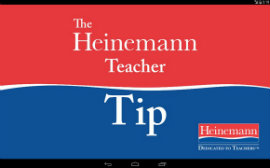4 Active-Learning Keys for Inclusion Classes
A MiddleWeb Blog

Remember, inclusion is a process—not a placement. It’s about the actions teachers take to make their classrooms a welcoming, risk-free, active learning environment where students have the opportunity to take charge of their own learning. Inclusion should never be a place where students with disabilities just sit amongst their peers in a general education setting.
So what’s happening in your classrooms to make inclusion a place where authentic learning takes place for all students?
Two resources to use right now
I recently downloaded The Teacher Tips App. Heinemann does it again with this free tool! The tips show up once a day and serve as a strong shot of energy to keep teachers on track for making the most of their instructional time.
As I looked through the past week’s tips, I noticed how each entry results in students really experiencing the learning process. Teachers facilitate and model, but students are always playing an active role in personally connecting and attaching meaning, which allows them to stay firmly on their own learning journey paths.
Teachers must be careful not to be the ones talking all the time. For example, The Teacher Tip on January 30, Don’t Fix the Story: Just Listen, reminds teachers to value the thinking of their students. And in return the students will begin to strengthen their confidence, their voice, and their independent learning actions.
As I read through each tip, I keep thinking…Oh! How so very UDL! Each of the Heinemann tips has the UDL Principles and Guidelines naturally embedded to boost the very essence of the instruction and learning process!
In inclusive settings it’s even more critical to ensure that students with special needs are respected as thinkers. They must get the scaffolding they need along with the opportunity to connect to their strengths and abilities so they can experience learning in positive ways.
Another resource that sparks my enthusiasm for creating experiential, meaningful learning environments is The Universal Design for Learning Implementation and Research Network (UDL-IRN) which shares The Critical Elements of UDL in Instruction, the spark for some some of my thinking in the remainder of this post.
Four keys to active learning in inclusion classrooms
Four words come to mind when I think about planning for active learning and student success in inclusive settings: Intentional, Clear, Flexible and Timely.
Intentional: Co-teachers must know their students’ strengths and needs and proactively create lessons that form a clear path between the students’ thinking and the content. Check out this Class Profile Template to help you to organize your thoughts and knowledge of your students. Once you have it filled out, keep it handy to guide your lesson planning.
Clear: Make sure that your learning targets are clear to you AND to your students. Students are definitely more motivated when they know what they are doing, why they are doing it, and what is expected of them. So once you have your clear learning targets, write them in student friendly statements and display for all to see. You could even write the learning target on the top of a student handout – some students really benefit from having this important focus right in front of them.

During the intentional planning phase, make sure to be flexible in your intention to offer multiple means of how students will engage, how you will present the material, and how students will express what they know and are able to do. Provide choice for students, but make sure that the choices are aligned with the students’ strengths and abilities as indicated in your class profile template.
Timely: A teacher’s job is endless. There’s just so much to think about and so many tasks to accomplish each day. Sometimes don’t you wonder: How did I get all of that done! But let’s face it…we can all remember those teachers who took forever to return a graded assignment or a test that we had shambled through. And by the time we got the assignment or test back, we had already moved on – no meaningful memory of what we learned. The moments were lost.
Luckily, teachers today know better! We know all about the value of specific, timely feedback. We know that when we provide our students with specific feedback within or near the moments of learning, they will grab on, attach personal meaning, and go deeper.
We are also savvy in our use of formative assessments. We are constantly assessing what they know and are able to do—and that knowledge informs our instruction each day. And the best part is that we are providing opportunities for our students to take charge of their learning. Life is good!
So, what do you think? How are you and your co-teacher putting these four keys into action in your classroom?
































I loved hearing your 4 keys for active learning. I yearn to have a co-taught classroom, but unfortunately it is just me. I am struggling to find the same balance that you describe with a co-taught class, but single-handedly. I found your site very refreshing and inspiring. I have been motivated to check out several of your links that are truly helpful. Thank You. Kris
I loved reading these four keys. I have spent all my time in special ed in a self-contained classroom. I have no real experience in a co-taught classroom but reading these keys are a great starting point if in the future I end up working in a co-taught classroom.
hello,, can u help me.. Do you have refences or expert which talk about Four keys to active learning in inclusion classrooms?
I really need this refences to complete the data in my research…
Hi, Wulan,
The four keys are my ideas based on my connections and experiences as I apply UDL –all links have been included as references. Would love to hear more about your research–please share–and let me know if you would like to connect further.
All the best and good luck with your research!
-Elizabeth